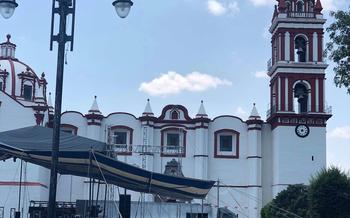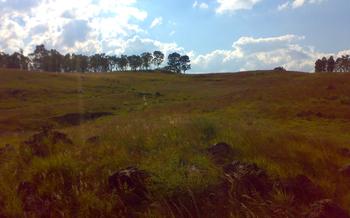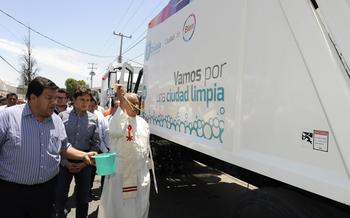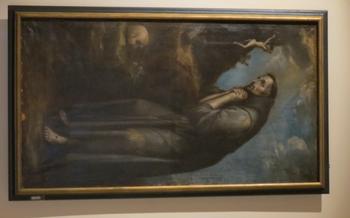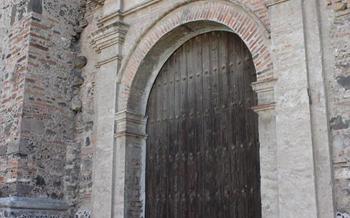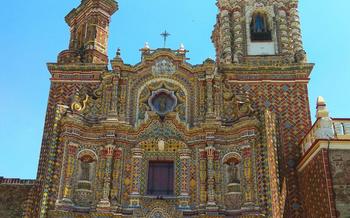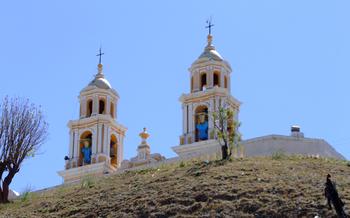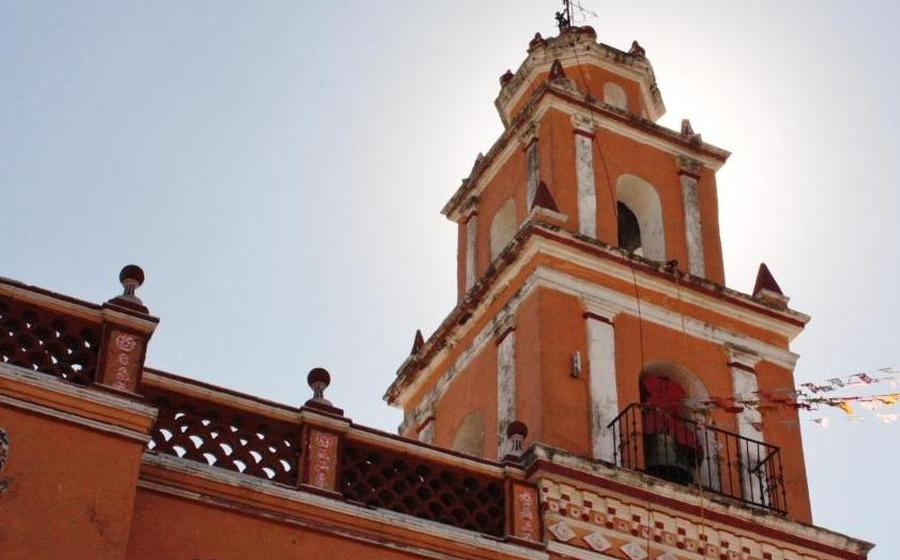
La Barrica Museum
- Historical Background
- La Barrica Museum: An Overview
- Permanent and Temporary Exhibits
- The Story of Pulque: A Local Tradition
- Exploring the Museum's Collections
- Unveiling Cholula's Rich History
- Local Artisans and Craftsmanship
- The Museum's Educational Programs
- Photography and Social Media
- Accessibility and Visitor Services
- Surrounding Attractions
- Seasonal Events and Festivals
- Local Cuisine and Dining Options
- Insider Tip: Secret Rooftop Terrace
Historical Background
Cholula, a city steeped in history, can trace its origins back to pre-Columbian times. The Great Pyramid of Cholula, the largest pyramid in the Americas by volume, stands as a testament to the ingenuity and architectural prowess of the ancient Cholutecans. Constructed over several centuries, this colossal structure served as a sacred site for religious rituals and ceremonies. In the 16th century, the arrival of the Spanish marked a turning point in Cholula's history. The city embraced Christianity and became a prominent center of colonial rule. The construction of churches, monasteries, and haciendas transformed the cityscape, blending indigenous and European influences. Cholula played a significant role in the Mexican War of Independence, actively supporting the insurgent movement led by Miguel Hidalgo. The city's strategic location and its history of resistance made it a crucial battleground in the fight for independence.
La Barrica Museum: An Overview
La Barrica Museum, conveniently situated in the heart of Cholula's historic center, offers a captivating journey into the region's rich cultural heritage. Established in 1984, the museum occupies a beautifully restored 18th-century building, known as "La Barrica." This architectural gem, with its thick adobe walls and traditional tile roof, serves as a fitting backdrop for the museum's diverse collection.
The museum's mission centers on preserving and showcasing the cultural legacy of Cholula, from its pre-Hispanic roots to the colonial era and beyond. Through its permanent and temporary exhibits, La Barrica Museum provides visitors with a comprehensive understanding of the region's history, traditions, and artistic expressions.
Permanent and Temporary Exhibits
The La Barrica Museum houses a diverse collection of permanent and temporary exhibits that offer visitors a glimpse into the rich history and culture of Cholula. The permanent collection features a wide range of artifacts, paintings, and sculptures that showcase the region's artistic and cultural heritage. Highlights include pre-Columbian pottery, intricately woven textiles, and colonial-era religious objects.
Temporary exhibits rotate on a regular basis, bringing fresh perspectives and new themes to the museum. These exhibits often focus on specific aspects of Cholula's history, such as the role of women in society or the influence of different cultural groups on the city's development.
The museum's curatorial approach emphasizes the interconnectedness of Cholula's past and present. Exhibitions are designed to engage visitors and encourage them to explore the complex layers of the city's history and culture. Interactive elements, such as touchscreens and audio guides, help visitors delve deeper into the stories behind the artifacts and artworks on display.
In addition to its permanent and temporary exhibits, the La Barrica Museum also offers a variety of educational programs and activities for visitors of all ages. Guided tours, workshops, and lectures provide opportunities for visitors to learn more about Cholula's history and culture, and to engage with the museum's collections in a hands-on way.
The Story of Pulque: A Local Tradition
Pulque, a traditional Mesoamerican alcoholic beverage made from fermented maguey sap, holds a significant place in Cholula's history and culture. Its roots can be traced back to pre-Columbian times, where it played a vital role in religious ceremonies and festivals. The indigenous people of Cholula believed that pulque was a sacred drink, a gift from the gods, and used it in rituals to honor their deities.
Pulque production in Cholula followed traditional methods passed down through generations. The maguey plant, also known as agave, was carefully cultivated and tended to for several years before it reached maturity. Once mature, the heart of the plant, called the piña, was harvested and its sap extracted. The sap was then collected in containers and left to ferment naturally, a process that could take several days or even weeks.
Pulque held both religious and social significance in pre-Columbian society. It was consumed during religious ceremonies, often as an offering to the gods, and was also a popular drink at festivals and celebrations. The frothy, milky liquid was considered a sacred beverage with medicinal properties and was believed to have healing powers.
In recent years, there has been a revival of interest in pulque, and its production has been revitalized in Cholula. Local producers are working to preserve this traditional beverage and promote its cultural significance. Visitors to Cholula can find pulquerías, or pulque bars, throughout the city, where they can sample this ancient drink and learn more about its history and cultural importance.
Exploring the Museum's Collections
The La Barrica Museum houses a diverse collection of artifacts, artworks, and historical documents that provide a glimpse into the rich history and culture of Cholula. Thematic sections or galleries within the museum showcase different aspects of the region's past, from pre-Columbian times to the colonial era and beyond.
One of the highlights of the permanent collection is the display of ancient pottery, including intricate figurines, decorative vessels, and ritual objects. These artifacts offer insights into the artistic traditions and craftsmanship of the ancient Cholutecans. Visitors can also admire a collection of textiles, such as finely woven garments, tapestries, and ceremonial fabrics, which showcase the skills and artistry of local weavers.
Among the notable religious artifacts in the museum are stone sculptures of deities, incense burners, and ceremonial masks. These objects provide a glimpse into the spiritual beliefs and practices of the ancient inhabitants of Cholula. The museum also houses a collection of colonial-era paintings and sculptures that depict religious scenes, portraits of notable figures, and everyday life in Cholula during the Spanish colonial period.
The curatorial process at the La Barrica Museum involves careful selection and arrangement of artifacts to tell a cohesive story about Cholula's past. Interactive displays and multimedia presentations enhance the visitor experience, providing additional context and information about the artifacts and their significance. Through its well-curated collections, the museum offers visitors a deeper understanding of the cultural heritage and historical legacy of Cholula.
Unveiling Cholula's Rich History
La Barrica Museum is a treasure trove of artifacts and stories that provide a glimpse into the vibrant history of Cholula. The exhibits take visitors on a journey through time, revealing the daily lives, customs, and beliefs of ancient Cholutecans. Through pottery, textiles, and religious objects, the museum showcases the cultural legacy of the Olmecs, Toltecs, and Aztecs, who each left their mark on the city.
The Spanish colonial period brought its own unique influences, as evidenced by the architectural landmarks and traditions that remain today. The museum sheds light on this era, highlighting the impact of Spanish rule on Cholula's development and its role in shaping Mexico's national identity. Visitors can explore the intricate connections between the city's pre-Columbian roots and its colonial heritage, gaining a deeper appreciation for the rich tapestry of Cholula's history.
Local Artisans and Craftsmanship
Cholula is renowned for its vibrant artisan community, whose skills and creativity have played a pivotal role in shaping the city's cultural identity. Visitors to La Barrica Museum will have the opportunity to discover the diverse range of traditional crafts that have been passed down through generations in Cholula. Among the most notable crafts are pottery, weaving, and metalworking.
The intricate pottery of Cholula is a testament to the skill and artistry of local artisans. Using ancient techniques, they transform clay into beautiful and functional objects, such as vases, plates, and figurines. The vibrant colors and intricate designs of Cholula pottery reflect the city's rich cultural heritage and make each piece a unique work of art.
Weaving is another important craft in Cholula. Local artisans use traditional backstrap looms to create colorful textiles, often featuring intricate patterns and motifs. These textiles are not only beautiful but also serve a variety of purposes, from clothing and blankets to bags and wall hangings.
Metalworking is another area where Cholula's artisans excel. They use a variety of techniques, including forging, casting, and filigree, to create intricate jewelry, sculptures, and other decorative objects. The intricate designs and fine craftsmanship of Cholula's metalwork are a testament to the skill and dedication of local artisans.
By supporting local artisans and purchasing their handmade souvenirs, visitors to La Barrica Museum can contribute to the preservation and promotion of Cholula's rich cultural heritage. These artisans are the keepers of ancient traditions, and their work is an integral part of what makes Cholula a unique and captivating destination.
The Museum's Educational Programs
La Barrica Museum offers a range of educational programs to engage visitors of all ages and interests. Guided tours led by knowledgeable docents provide in-depth insights into the museum's collections and the history of Cholula.
-
School Groups: The museum welcomes school groups and tailors guided tours to suit different grade levels and curricula. Interactive activities and hands-on experiences make learning about Cholula's rich history fun and engaging for young minds.
-
Workshops and Activities: The museum hosts regular workshops and activities that allow visitors to delve deeper into specific aspects of Cholula's culture and history. These hands-on sessions can include pottery making, traditional weaving, or cooking classes, providing a unique opportunity to learn from local artisans and immerse oneself in the local traditions.
-
Lifelong Learning: The museum is committed to promoting lifelong learning and offers educational programs for adults as well. Lectures, seminars, and film screenings explore various topics related to Cholula's history, culture, and contemporary issues, fostering a vibrant intellectual community.
-
Online Resources: For those unable to visit the museum in person, La Barrica Museum offers a range of online resources. Virtual tours, interactive exhibits, and educational videos bring the museum's collections and stories to life, making them accessible to a global audience.
Photography and Social Media
The La Barrica Museum encourages visitors to capture their experiences through photography and share their discoveries on social media. Photography is permitted in most areas of the museum, allowing visitors to document their journey through the rich history and culture of Cholula. By using the hashtag #LaBarricaMuseum, visitors can connect with others who share their passion for history and culture, and contribute to the museum's online community.
The museum recognizes the power of social media in promoting its collections and engaging with a broader audience. Through its social media channels, the museum shares stories, highlights artifacts, and announces upcoming events, providing a platform for visitors to interact with the museum and learn more about its treasures.
Whether it's capturing the intricate details of an ancient artifact or sharing a moment of inspiration in the museum's galleries, visitors are encouraged to document and share their experiences at La Barrica Museum. By doing so, they help spread the word about this hidden gem and contribute to the preservation and promotion of Cholula's cultural heritage.
Accessibility and Visitor Services
The La Barrica Museum is committed to providing a welcoming and accessible environment for all visitors. The museum features a variety of accessibility features to ensure that everyone can enjoy and learn from its exhibits. Ramps and elevators provide easy access to all floors of the museum, and audio guides are available for visitors with hearing impairments. Restrooms, cloakrooms, and other visitor amenities are conveniently located throughout the museum.
Families with young children will appreciate the museum's family-friendly atmosphere. Strollers are welcome, and there is a designated play area where children can engage in hands-on activities related to the museum's exhibits. Visitors with special needs can request assistance from museum staff, who are trained to provide support and ensure a positive experience for all.
Multilingual options are available for visitors who do not speak Spanish. Guided tours in English are offered regularly, and translation services can be arranged for visitors who require assistance in other languages. The museum's website and signage are also available in multiple languages to ensure that everyone can access information about the exhibits.
With its commitment to accessibility and visitor services, the La Barrica Museum welcomes visitors from all backgrounds and abilities to explore and learn about the rich history and culture of Cholula.
Surrounding Attractions
Exploring the La Barrica Museum can serve as a gateway to discovering Cholula's other captivating landmarks. A short walk from the museum leads to the majestic Great Pyramid of Cholula, an ancient monument that rivals the pyramids of Egypt in size. Visitors can climb to the top of the pyramid for breathtaking views of the city and the surrounding countryside. Other nearby attractions include the Church of Santa María Tonantzintla, renowned for its elaborate Baroque architecture and indigenous motifs, and the Museo Regional de Cholula, which houses a collection of artifacts and exhibits showcasing the city's rich history. For a unique perspective, take a leisurely stroll through the colorful Mercado Municipal de Cholula, where vendors sell a variety of local handicrafts, produce, and traditional snacks.
Seasonal Events and Festivals
Cholula, steeped in history and tradition, comes alive during its annual events and festivals. These vibrant celebrations showcase the city's rich cultural heritage, offering visitors a chance to immerse themselves in the local spirit.
One of the most significant events is the Festival de la Virgen de los Remedios, held in September. This grand festival honors the city's patron saint, the Virgin of Remedies, with processions, traditional dances, and colorful festivities.
During the Carnaval de Cholula, the streets erupt in a riot of colors, music, and revelry. This pre-Lenten celebration features parades, costume contests, and lively performances, capturing the essence of Mexican alegría (joy).
For those seeking a taste of Cholula's culinary delights, the Feria Nacional del Chile en Nogada in August is a must-attend. This festival celebrates the iconic dish, Chile en Nogada, a poblano pepper stuffed with picadillo, topped with a creamy walnut sauce, and garnished with pomegranate seeds, representing the colors of the Mexican flag.
These events provide a unique opportunity to witness Cholula's vibrant traditions, connect with its people, and experience the city's infectious energy. Make sure to plan your visit around these festivals to fully immerse yourself in the cultural tapestry of Cholula.
Local Cuisine and Dining Options
Exploring the culinary delights of Cholula is an essential part of experiencing the city's rich cultural heritage. After immersing yourself in the fascinating exhibits at La Barrica Museum, indulge in a culinary adventure by venturing into the surrounding streets and discovering the flavors that define Cholula's cuisine.
For an authentic taste of the region, head to local restaurants or eateries that have stood the test of time, serving traditional dishes passed down through generations. Savor the flavors of mouthwatering mole poblano, a complex and flavorful sauce made with a variety of chili peppers, spices, and chocolate, often paired with tender chicken or turkey.
Don't miss the opportunity to try cemitas, a local specialty consisting of a fluffy sesame seed bun filled with your choice of meats, such as slow-cooked pork, chicken, or beef, topped with fresh vegetables, avocado, and a drizzle of salsa.
For a refreshing treat, quench your thirst with a glass of pulque, a traditional fermented beverage made from the sap of the maguey plant. Pulque holds a special place in Cholula's history and culture, and you can find it in many local establishments.
By supporting local businesses and sampling the diverse culinary offerings of Cholula, you not only satisfy your taste buds but also contribute to the preservation and celebration of the city's rich culinary traditions.
Insider Tip: Secret Rooftop Terrace
Venture beyond the museum's galleries and discover a hidden gem - the secret rooftop terrace. This oasis offers a breathtaking panorama of Cholula, with its sprawling cityscape, vibrant markets, and the iconic Great Pyramid in the distance.
As the sun begins its descent, the terrace transforms into a magical spot to witness the sky ablaze with color. The golden hues of the sunset cast a warm glow on the city, creating a picture-perfect moment.
To access this hidden gem, inquire at the museum's information desk. Be prepared to climb a few flights of stairs, but the reward is worth the effort. The terrace is open to visitors during museum hours, so plan your visit accordingly.
Whether you're seeking a tranquil retreat or a unique perspective of Cholula, the secret rooftop terrace is a must-visit for any traveler. Let the panoramic views captivate you and create lasting memories of your visit to La Barrica Museum and the enchanting city of Cholula.


